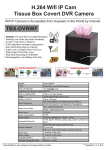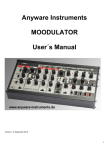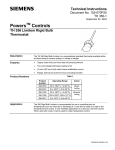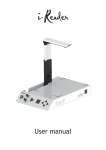Download ASP user manual
Transcript
S4 Tech Inc S4 Tech Wide Area Command and Control System User Manual Version 1.0 November 20, 2012 0 S4 Tech Inc Table of Contents System Description....................................................................................................................................................... 3 Radar Interface kit ........................................................................................................................................................ 3 Connecting the Radar to the Base Station ............................................................................................................... 4 Connecting the Optional Radar GPS .................................................................................................................... 7 Software Connection and Configuration of the Radar ............................................................................................ 7 QuickStart Configuration ..................................................................................................................................... 8 Network Configuration for the Radar.................................................................................................................. 9 Viewing Radar Data ........................................................................................................................................... 10 Configure the Radar Outputs for the Wide Area Command and Control Software......................................... 11 PTZ Wide Area Scan System ....................................................................................................................................... 11 Setting up the PTZ Wide Area Scan System ........................................................................................................... 12 Network Configuration for the PTZ Camera ...................................................................................................... 13 Running the S4 C2 Application ................................................................................................................................... 13 The Map Tab .......................................................................................................................................................... 14 Changing or Loading a Map ............................................................................................................................... 15 Adding a Radar ....................................................................................................................................................... 17 Configuring the Radar Position.......................................................................................................................... 18 The Cameras Tab ................................................................................................................................................... 18 PTZ Cameras ...................................................................................................................................................... 18 Fixed Cameras ................................................................................................................................................... 20 DVR Configuration ............................................................................................................................................. 21 Using the Map Interface ........................................................................................................................................ 22 Lat/lon Position ................................................................................................................................................. 22 Distance and Bearing Measuring ....................................................................................................................... 22 Slew to Cue ........................................................................................................................................................ 22 Automatic Radar Target Tracking ...................................................................................................................... 22 Video Display ..................................................................................................................................................... 23 PTZ Wide Area Scanning Function ......................................................................................................................... 24 Enter an Area Scan Profile ................................................................................................................................. 24 Enter a Tour Scan Profile ................................................................................................................................... 25 1 S4 Tech Inc Exit the Application ................................................................................................................................................ 26 Troubleshooting ......................................................................................................................................................... 26 Contact Info/Tech Support......................................................................................................................................... 26 Table of Figures Figure 1: Radar Kit with Military Grade Case ............................................................................................................... 3 Figure 2: Radar Interface Kit Identification Label......................................................................................................... 4 Figure 3: Radar Remote Module CAT-5 Primary Connections (125m or less) ............................................................. 4 Figure 4: Radar Remote Module CAT-5 Auxillary Connections (125m -450m) ............................................................ 5 Figure 5: Connecting Radar Remote Module to Base Station...................................................................................... 5 Figure 6: Powering Up the Radar Base Station ............................................................................................................ 6 Figure 7: Connecting Radar Base Station to Computer................................................................................................ 6 Figure 8: Connecting GPS to the Radar ........................................................................................................................ 7 Figure 9: Radar IP Address Decal ................................................................................................................................. 7 Figure 10: Connect to Radar with Chrome Browser .................................................................................................... 8 Figure 11: Radar Software Quickstart Config Tab ........................................................................................................ 9 Figure 12: Radar Software Network Config Screen...................................................................................................... 9 Figure 13: Radar Tracker Display Screen .................................................................................................................... 10 Figure 14: Display Config Menu ................................................................................................................................. 10 Figure 15: Configure the Radar for S4 C2 Software ................................................................................................... 11 Figure 16: PTZ Scan Area Equipment ......................................................................................................................... 12 Figure 17: PTZ Connection ......................................................................................................................................... 12 Figure 18: PTZ Adapter IP Address ............................................................................................................................. 13 Figure 19: Start S4 C2 Software.................................................................................................................................. 13 Figure 20: S4 C2 Help Document................................................................................................................................ 14 Figure 21: S4 C2 Map Tab with 500m Default Grid .................................................................................................... 15 Figure 22: Main Config Menu on Map Tab ................................................................................................................ 16 Figure 23: Default Map .............................................................................................................................................. 16 Figure 24: Radar Bearing and Position Verification ................................................................................................... 18 Figure 25: Add PTZ Camera ........................................................................................................................................ 19 Figure 26: Place PTZ Camera on Map/Grid ................................................................................................................ 19 Figure 27: Add Fixed Camera ..................................................................................................................................... 20 Figure 28: Place Fixed Camera on Map/Grid ............................................................................................................. 20 Figure 29: Camera and DVR Configuration ................................................................................................................ 21 Figure 30: DVR Alert Notification Configuration ........................................................................................................ 21 Figure 31: Enter Scan Area Profile.............................................................................................................................. 24 Figure 32: Enter Tour Scan Profile.............................................................................................................................. 25 Figure 33: Enter Tour Scan Preset Point .................................................................................................................... 25 2 S4 Tech Inc System Description The S4 Tech Wide Area Command and Control (WAC2) System extends the DOG Base Station capabilities to include a geo-referenced map based user interface along with graphical controls for radars, PTZ cameras, and fixed cameras. The software provides slew to cue capability in which radar targets or sensor detections can be rapidly assessed by automatically pointing a PTZ camera at the alarm location. An area scanning capability allows large flat areas to be scanned with video motion detection for wide area surveillance. A tour scanning capability allows the operator to select up to 128 arbitrary points with individual focus and zoom levels, and then directs the camera to each of the selected points where it performs video motion detection. This allows a number of threat locations to be covered by a single PTZ camera. The WAC2 software application combines maps, grids, and icons with Spotter radars, DOG Base Stations, DOG standard cameras, DOG PTZ cameras, and DOG sensors. The software allows the user to select a default grid display or to import a map image in any standard image format. Fixed camera, PTZ camera, sensor, and radar icons can be placed on the grid or maps and alarms are indicated both visually and audibly. Radar targets are displayed with persistence tracks. The WAC2 System can be used with DOG radars, PTZ cameras, fixed cameras, and intrusion sensors. The following sections discuss how to set up each of these sensor types. Radar Interface kit The DOG Radar Interface Kit provides the capability to remotely power and connect to a DOG radar sensor and to display and configure the radar data on the base station laptop. The DOG radar interface kit will power a Spotter radar out to 150m with a single (primary) CAT-5 cable and up to 500m using a second CAT-5 cable. The figure below shows the various components in the DOG Radar Interface Kit. Figure 1: Radar Kit with Military Grade Case 3 S4 Tech Inc Each case is identified by a decal just above the handle as shown in the figure below. Figure 2: Radar Interface Kit Identification Label Connecting the Radar to the Base Station Begin connecting the Radar to the Base Station by removing the weatherproof connector gland for the connector labeled J1. Run a CAT-5 cable through the weatherproof gland and plug the RJ-45 connector into J1 as shown in the figure below. If the cable distance being run from the radar to the base station is 125m or less in length then J1 is the only connection that needs to be made between the radar and the base station. In this case it is extremely important to put a small piece of CAT-5 cable into the other cable gland to insure an environmentally tight seal. ***WARNING*** DO NOT REMOVE THE WEATHERTIGHT CONNECTOR ON THE BOTTOM OF THE RADAR HEAD. CONNECTING THE PRIMARY OR SECONDARY CABLES DIRECTLY INTO THE RADAR MAY DAMAGE THE RADAR. Figure 3: Radar Remote Module CAT-5 Primary Connections (125m or less) 4 S4 Tech Inc When connecting the Radar to the Base Station over distances betweem 125m and 450m a second CAT-5 cable needs to be run and connected to the J3 connector to extend the operational capabilities as shown in the figure below. ***WARNING*** DO NOT REMOVE THE WEATHERTIGHT CONNECTOR ON THE BOTTOM OF THE RADAR HEAD. CONNECTING THE PRIMARY OR SECONDARY CABLES DIRECTLY INTO THE RADAR MAY DAMAGE THE RADAR. Figure 4: Radar Remote Module CAT-5 Auxillary Connections (125m -450m) Once the CAT-5 cables have been plugged into the the Radar Remote Module the other end of the cables can be connected to the Radar Base Station. The primary cable that was plugged into connector J1 on the Radar must be plugged into the connector labeled J6 on the Base Station. If second cable is plugged into connector J3 on the Radar then connect the other end of this cable into the connector labeled J7 on the Base Station. Figure 5: Connecting Radar Remote Module to Base Station 5 S4 Tech Inc It is highly recommended to attach a grounding wire to the grounding post on the Radar Base Station and clamp the other end to a to a large metal structure, pipe, or electrical outlet ground as shown in the figure below. This will help to protect the hardware and user against lightning. Next plug in the 40Vdc adapter into the J5 connector on the Radar Base Station to power up the radar. Figure 6: Powering Up the Radar Base Station With the Radar and Radar Base Station powered up connect a CAT-5 cable to any of the connectors labeled J1-J4 on the Radar Base Station to the Base Station computer. Figure 7: Connecting Radar Base Station to Computer 6 S4 Tech Inc Connecting the Optional Radar GPS To connect the optional GPS to the DOG Radar first plug in the GPS connector into the Radar as shown in the figure below. The GPS contains a magnetic strip that will allow it to easily attach to the top of the radar and stay without any mounting hardware. Figure 8: Connecting GPS to the Radar Software Connection and Configuration of the Radar Once everything is properly connected, power up the system. The Radar takes approximately thirty seconds to a minute to fully power up and initialize. Use the Base Station laptop to open up a Google Chrome web browser by double clicking on the Google Chrome icon as seen in the figure below. The IP address of the Radar is set to 192.168.0.20 and can be seen on a decal on the radar case as seen in the picture below. Figure 9: Radar IP Address Decal 7 S4 Tech Inc The Chrome browser is set to automatically load the Radar’s configuration page when it is run. The IP address of the Base Station laptop is usually set to 192.168.0.3 or 192.168.0.13. Figure 10: Connect to Radar with Chrome Browser QuickStart Configuration Whenever a Radar is installed in a new location it is important to configure several radar settings. Click on the “Quick Start” tab at the top of the web browser to see the screen in the figure below. The Environment: Wind Speed setting is used to help eliminate false alarms generated by the wind blowing trees and other objects within the Radars field of view. Increaseing the environment wind speed reduces the sensitivy of the Radar. It is recommended to start with a slow wind speed and gradually increase the setting until all false alarms stop. The Orientation: Azimuth Setting is critical to properly aligning Radar’s angle relative to north. Type in the angle (in degrees) relative to true north that the radar is pointing. Note: If the S4 Tech WAC2 map based software is used then this is done automatically. The Location: Lat, Long, Elevation setting is critical for determing the exact location of the Radar. If the GPS module is connected to the Radar then the location information will automatically be uploaded to the software. The location information can also be manually entered should it be necessary. Note: If the S4 Tech WAC2 map based software is used then this is done automatically based on the location (lat/lon) of the point that the user clicks on in the map. Once all of the Radar settings have been properly configured it is important to click on the “Save” button at the bottom of the webpage to save all of the settings. Note** Consult the Radar’s user manual for a more detailed description of these settings as well as many other non-critical settings. The manual is available via the browser. 8 S4 Tech Inc Figure 11: Radar Software Quickstart Config Tab Network Configuration for the Radar As mentioned above, the IP address of the radar is set to 192.168.0.20 and the subnet mask is 255.255.255.0 as seen in the figure below. If for some reason this address were to be changed or corrupted, the user can connect to the default ip address of the radar at 169.254.254.254. In this case the Base Station laptop must be set to the same subnet 169.254.254.xxx. Figure 12: Radar Software Network Config Screen 9 S4 Tech Inc Viewing Radar Data Once the Radar has been properly setup click, on the “Tracker” tab in the upper right hand corner of the webpage. The Radar’s Tracker Display page will open up in a new browser window as shown in the figure below. Figure 13: Radar Tracker Display Screen The grid display shows the range and angle contours along with the radar personnel detection pattern. Target tracks are displayed as unique colored squares with an adjacent track ID as seen in the figure above. The range and bearing associated with the track ID are displayed in a matching color in the upper left or right corner of the grid. The display can be configured by clicking on the SpotterRF icon in the upper left corner of the grid. When clicked on, the icon expands into the high level configuration menu options as seen in the figure below. Click on each option to set up background color, line and text sizes, grid labels, target display options, etc. Mask zones can also be set up so that no detections occur in those areas. Figure 14: Display Config Menu 10 S4 Tech Inc Configure the Radar Outputs for the Wide Area Command and Control Software The first step in running the S4 Tech WAC2 application is to configure the radar to send target data to that application. This is done in the Outputs tab of the radar browser page as seen in the figure below. Use the settings in the figure to set up radar target data communication to the laptop running the S4 WAC2 application. Make sure that the IP address is set to match that of the laptop. Note: If the S4 Tech WAC2 map based software is used then this is done automatically when the radar is added. Figure 15: Configure the Radar for S4 C2 Software Note** To check that the rada is outputting target data open another Google Chrome browser page and enter the following url: 192.168.0.20/tracks.json. You will see the latest serial message sent by the radar in the browser window. PTZ Wide Area Scan System The PTZ Wide Area Scan System is used to scan large flat areas or to check a number of seleced points around the threat perimeter. The wide area scan system hardware consists of one or more DOG high performance low light PTZ cameras (with or without the thermal camera option) and a PTZ Network Interface Unit as seen in the figure below. 11 S4 Tech Inc Figure 16: PTZ Scan Area Equipment The PTZ Wide Area Scan System can perform an Area Scan that utilizes video motion detection to scan a large clear flat area looking for any movement. When movement is detected an alarm is generated and the user can assess the alarm via the camera and take control of the camera if needed. The Wide Area Scan System can also perform a tour scan in which the operator points a PTZ camera at up to 128 points along the perimeter and inputs each point into the software including zoom and focus levels for that point. The tour scan software will then direct the camera to each point and enable motion detection for a user specified number of seconds before continuing to the next point. If a video motion alarm is received the camera will dwell on that point for a user specified number of seconds before moving on. Setting up the PTZ Wide Area Scan System Figure 17: PTZ Connection 12 S4 Tech Inc Network Configuration for the PTZ Camera The default IP address of the PTZ camera is set to 192.168.0.10:10001 and the subnet mask is 255.255.255.0 as seen in the decal on the unit in the picture below. If additional PTZ cameras are provided, their default IP addresses will be indicated on the decal. The WAC2 application has the PTZ Cameras coded internally so there is currently no need to configure these parameters. Figure 18: PTZ Adapter IP Address Running the S4 C2 Application Once the radar outputs have been configured to run the S4 Tech Command and Control application double-click on the S4 Command and Control desktop icon as indicated in the figure below to launch the application. Figure 19: Start S4 C2 Software 13 S4 Tech Inc The S4 Command and Control application will open up in a new window. Note** If no DOG Base Station or PTZ camera are connected to the laptop then it may take a minute or two before the application opens as it searches for connected devices. Once open the user can click on the Help menu on the upper left to see a full set of help instructions for the application. The main page of the help menu is seen in the figure below. Figure 20: S4 C2 Help Document The Map Tab The figure below shows the Map tab of the application. It contains a default 500m grid with a radar, fixed camera, and PTZ camera placed on the grid. The radar personnel detection pattern is shown as yellow oval and it points in the direction of the user entered bearing for the radar. The PTZ and fixed camera fields of view and shown as green and blue fans respectively, and also point in the direction of the cameras. Motion detection or sensor alarms from a connected DOG Base Station DVR will cause the fans to turn red and flash along with an audible tone that can be disabled. Video from the corresponding alarms can be seen on the DVR under that camera’s channel. The virtual joystick in the upper right corner of the page will control one or more connected PTZ cameras. 14 S4 Tech Inc Figure 21: S4 C2 Map Tab with 500m Default Grid Changing or Loading a Map The default grids or maps can be changed by right clicking anyware on the map or grid graphic and using the popup menu as seen in the figure below. Maps can be added with the Import Map option or removed with the Remove Map option. See the Help menu for more details on this process. The default grid can be changed to a 250m or 1000m grid or to a default map by selecting the Swich Map option in the popus menu and then selecting the desired option in the submenu. Cameras and radars are added to the map using the pop-up menu also as seen by the options in the figure below. 15 S4 Tech Inc Figure 22: Main Config Menu on Map Tab The default map option is shown below. Figure 23: Default Map 16 S4 Tech Inc Adding a Radar Add Radar • Right click on the radar position on the Map, select Place Radar Here from the context menu • On the Place Radar dialog, enter the Name, Bearing, Radar IP address, and select the Radar type from the Type dropdown box. • The Launch Web Interface button will open a browser window that will allow configuration of the various radar parameters. Figure 24: Add Radar to Map • Click Ok, and the position and bearing settings are automatically uploaded to the radar. The radar icon with radar coverage pattern will be displayed on the map and the radar target subscription information will be automatically entered into the radar. Remove Radar • Right click anywhere on the Map, select Remove Radar from the context menu • On the Remove Radar dialog, select the radar you like to remove Figure 25: Remove Radar from Map • • Click the Remove button Click the Close button 17 S4 Tech Inc Configuring the Radar Position It is important that the radar bearing and position on the map or grid correspond to the Orientation [azimuth angle] and Position [Latitude (Lat),Longitude (Long)] shown in the radar browser or the targets will not display in the right locations. The radar bearing and lat/lon are automatically entered by the user when the radar is first placed onto the S4 C2 map. The bearing can be verified by the direction that the radar pattern is pointing as seen in the figure below. The user should verify that this matches with the Orientation:Azimuth Angle settings on the Quickstart tab of the radar browser. The radar location on the map is determined by where the user clicks the mouse before right clicking the pop-up menu to add the radar. The Lat/Long location of the mouse click can be seen in the bottom right of the screen as shown in the figure below. The user should verify that this matches with the Position: Lat/Long settings on the Quickstart tab of the radar browser. Figure 26: Radar Bearing and Position Verification The Cameras Tab The cameras tab is the where fixed cameras, PTZ cameras, and DVR units are set up in the S4 C2 application as seen on the main tab in the figure below. For each component that is added, submenus will pop up and the appropriate parameters must be entered by the user. PTZ Cameras PTZ cameras have name, IP addresses, TCP ports, DVR channel, and scan area parameters that must be entered as seen in the figure below. 18 S4 Tech Inc Figure 27: Add PTZ Camera Once a camera has been added it can be placed on the map or grid by right clicking the mouse on the desired location, selecting Place a PTZ Camera, and entering the parameters in the dialog box as seen below. Figure 28: Place PTZ Camera on Map/Grid 19 S4 Tech Inc Fixed Cameras Fixed cameras have name, DVR, and DVR channel parameters as seen in the figure below. Figure 29: Add Fixed Camera Once a camera has been added it can be placed on the map or grid by right clicking the mouse on the desired location, selecting Place a Fixed Camera, and entering the parameter in the dialog box as seen below. Figure 30: Place Fixed Camera on Map/Grid 20 S4 Tech Inc DVR Configuration To connect to a DOG Base Station DVR enter the IP address of that DVR and the number of channels that unit has (4 or 8). Figure 31: Camera and DVR Configuration The DVR should be configured through the Event Menu - Alert Notification Submenu to send alarms to the WAC2 application (IP Address 192.168.0.3 Port 9999). When an alarm is received by the DVR the corresponding camera icon will flash red on the map. Figure 32: DVR Alert Notification Configuration 21 S4 Tech Inc Using the Map Interface The map interface has several capabilities described below that are graphically controlled. Lat/lon Position Left click a point on map, the lat/lon position will be showed on the lower right corner of the screen. Distance and Bearing Measuring To measure the distance and bearing between two points on the map, left click the starting point and then drag the mouse to the end point. A yellow line will be drawn on the map following the mouse movement. The distance and bearing are showed on the lower right corner of the screen, as showed in the following figure. Releasing the mouse, the lat/lon of position of the end point will be showed as well. Figure 33: Distance and Bearing Measurement Slew to Cue Slew-to-cue capability allows the user to ctrl-click on a point on the grid or map and cause the PTZ camera to pan to that spot. This is typically used in conjunction with radar targets or sensor/camera alarms to visually assess the situation. Automatic Radar Target Tracking This capability allows the user to shift-click on a radar track on the grid or map. The PTZ camera will slew to the track location and as long as the radar track remains active, the PTZ camera will follow the target. Shift-click on 22 S4 Tech Inc one of the orange radar tracks in the figure below and the PTZ camera will slew to that target and continue to follow the target as long as the track remains active. Figure 34: PTZ Target Tracking Video Display To display live video on the computer monitor select a camera by placing the cursor over that camera's field of view (the triangle) on the grid or map and right clicking to get the menu shown below. Figure 35: Select Live Video Source Camera 23 S4 Tech Inc Select the camera and a window showing the camera's live video will open on the screen. You can resize the window and drag and drop it anywhere on the screen. This can be repeated for all the cameras on the map. Figure 36: Display Live Video on Map PTZ Wide Area Scanning Function Enter an Area Scan Profile An area scan will cause the PTZ camera to scan a user defined arc (1-360 degrees) in user defined degree increments and with a user defined PTZ tilt angle and stare time (how long the camera stops and stares with motion detection enabled at each increment). These parameters are set up using the Step and Stare by Angle PTZ parameters. The paramter entry dialog box is reached by adding a new PTZ camera (Add) or editing an existing PTZ camera (Edit) as shown in the figure below. Figure 37: Enter Scan Area Profile 24 S4 Tech Inc Enter a Tour Scan Profile A tour scan profile causes the PTZ to cycle through a set of user defined points in an arc from 1-360 degrees. The camera will stop and stare with motion detection enabled at each point for a user specified amount of time. Each of the tour points is set by using the virtual joystick to pan and tilt the camera to the desired location (using the monitor to verify the image). Once a desired point is reached the desired focus and zoom levels may also be set using the virtual joystick interface. At this point the preset may be added to the tour by selecting the Presets checkbox and clicking on Add as seen in the figure below. Figure 38: Enter Tour Scan Profile Ener the name of the preset along with a stare time (how long the camera will dwell on that spot with motion detection enabled) as seen in the figure below. The preset point will then be visible in the Preset Tour list. Continue adding points until the tour is complete. Select Start Tour to start the Tour Scan. Figure 39: Enter Tour Scan Preset Point 25 S4 Tech Inc Exit the Application To exit the S4 C2 application, click on the File menu and then select Exit or simply click on the X in the upper right corner of the application window and the application will shut down. Troubleshooting 1. The radar unit does not appear to power up. It may take several minutes for the data link to establish a connection with the radar. Also check the length of the CAT-5 cable connecting the radar. If it is over 100m then two CAT-5 cables are required out to 300m. 2. The radar does not appear to connect to the system. Open the Google Chrome browser window on the Base Station Processing Module and type in http://192.168.254.254 to connect to the radar. Contact Info/Tech Support For questions or support please see our website at: www.s4-tech.com or contact: [email protected], 703-956-9088 26






































